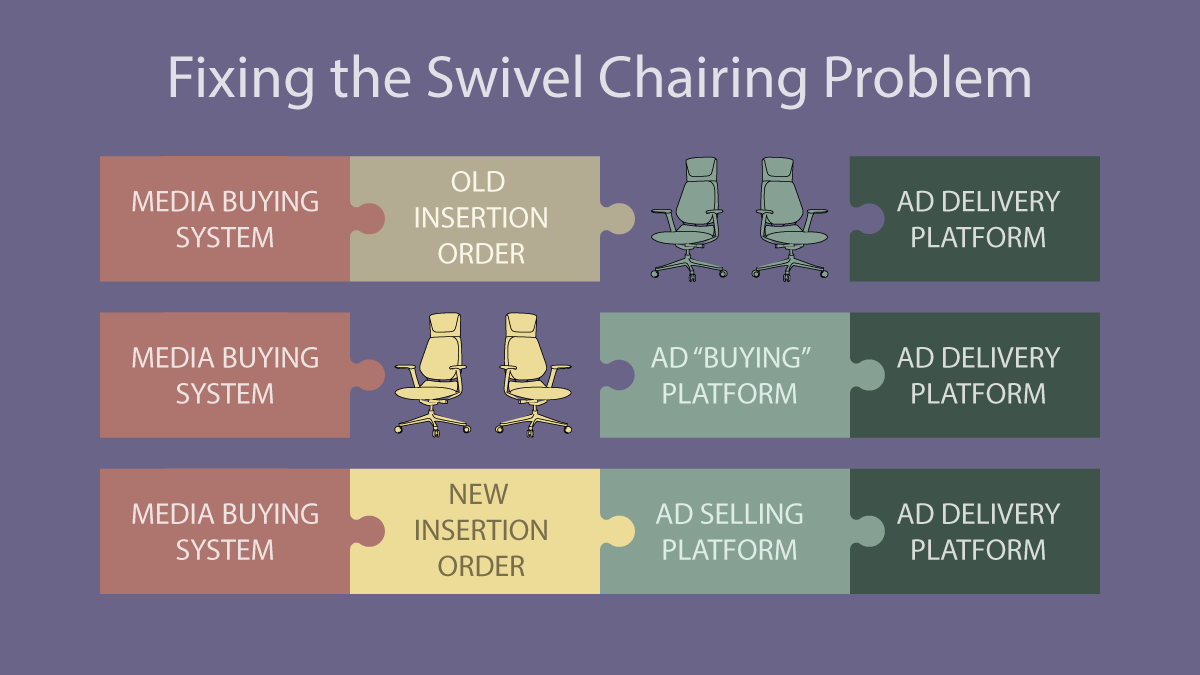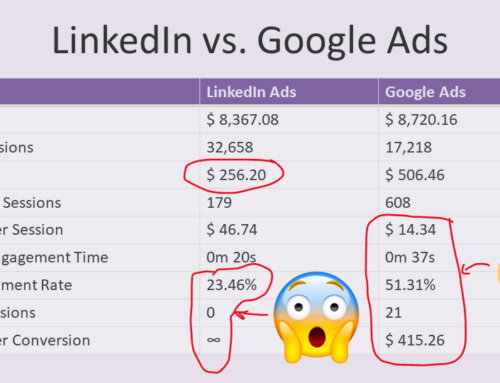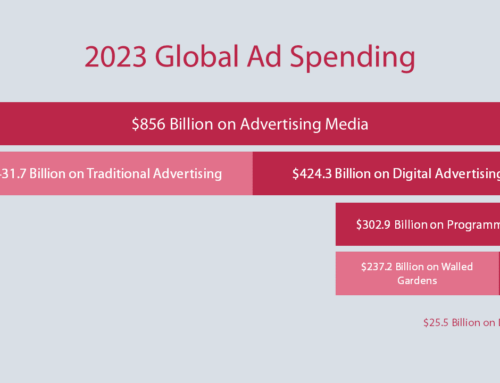Advertising has always had a swivel chairing problem. Digital advertising made it worse. Now, CTV, SPO, RMN, and new ad platforms are exacerbating the problem.
What is the Swivel Chairing Problem?
In today’s world of digital advertising, you have to work with many different ad platforms to deliver the placements in your media plan. Swivel chairing refers to the problem of having to manually switch between multiple platforms to set up, manage, and analyze ad campaigns.
The swivel chairing problem arises when ad technologies are not well-integrated, forcing you to “swivel” back and forth between different systems, both figuratively and literally.
Swivel chairing causes delays, requires re-keying, wastes time, increases costs, causes errors, hurts performance, wastes money, … the list goes on and on.
There’s not much to like about swivel chairing.
Swivel Chairing Used to Be the Seller’s Problem
Before digital advertising, swivel chairing used to be the seller’s problem.
The media buyer would send an insertion order to the ad sales team. Upon receipt, the seller would do all the work to make sure the ad was delivered over the air, in print, on a billboard, or whatever delivery channels were indicated in the IO.
The media buyer was not involved with these logistics. It was the seller’s responsibility to deliver the ads. If they failed to deliver, they didn’t get paid.
Swivel Chairing Has Become the Buyer’s Problem
Since the advent of digital advertising, the swivel chairing problem has gradually shifted from the seller to the buyer.
As self-serve ad buying platforms became available, media buyers have increasingly had to log into these platforms to place their ads. These sellers don’t want to take insertion orders anymore. They want you to do all the work of buying ads through their platform (versus just sending an order).
Because they primarily serve the seller’s priorities, these so-called ad “buying” platforms are more aptly named ad “selling” platforms.
For example, Google and Facebook have well-established ad “buying” platforms. If you want to advertise through Google or Facebook, you have to log in to their platform and do a bunch of work to place your ads. API integrated third party tools never provide the full capabilities of the platforms themselves and often add their own costs and complexities.
More Platforms, More Problems
Every new ad platform creates a new set of problems for media buyers.
Gaining Access
The first problem is gaining access to the platform. In many cases, this requires an overly complicated licensing process involving legal wrangling and taking on obligations such as minimum spending requirements.
This alienates lots of buyers.
Requires Training
The second problem is the learning curve. The media buying team has to learn how to use each new ad platform. Many of these systems are difficult to use because they are overly complex, poorly designed, or a combination of both.
This problem repeats itself with every new hire.
Requires a Time Investment
The third problem is using the ad platform. The already overworked media buying team has to spend hours entering their placements into the system. They have to double-check and triple-check their work to avoid making mistakes.
Nobody has time for this.
Needs Constant Monitoring
The fourth problem is monitoring ad performance. When the ads are supposed to be running, it’s the media buyer’s responsibility to make sure the ads are running properly and delivering the desired results. If not, it’s the buyer’s (not the seller’s) fault.
The Proliferation of Advertising Platforms
It seems like every day there’s a new advertising platform.
As each new walled garden gains traction, they establish their own ad platform.
Retail Media Networks
Retail Media Networks (RMN) have burst onto the scene. There are already more than 600 retail media networks. Many of them are building their own ad platforms.
Connected TV
Connected TV (CTV) is also blossoming. CTV providers are not going to repeat the mistakes of online display advertisers. To control access to their ad inventory, they are each establishing their own ad platforms.
Other Ad Platforms
Under the auspices of Supply Path Optimization (SPO), Demand Side Platforms (DSPs) and Sell Side Platforms (SSPs) are each creating end-to-end ad platforms that provide buyers with access to advertising inventory while eliminating intermediaries.
As a result of this innovation, media buyers have to deal with hundreds of ad “buying” platforms, with more coming every day.
Swivel Chairing Isn’t Sustainable
Swivel chairing all these ad platforms is not sustainable.
If you’re a media buyer, the escalating problems from swivel chairing will downgrade your service, damage your client relationships, and erode your margins.
If you’re a seller building a new ad platform, good luck. You’re going to need it.
If you’re not already an 800-pound gorilla, your odds of winning the lottery are better than your odds of gaining meaningful adoption among media buyers.
How to Solve the Swivel Chairing Problem
A viable solution to the swivel chairing problem is insertion orders. Yes, insertion orders.
I heard you snicker. Please, hear me out…
First, insertion orders have already been proven to work. Media buyers never had swivel chairing problems until we got away from insertion orders.
Second, we already have systems in place. Every media buying system can produce insertion orders.
Third, most ad sales organizations already accept insertion orders. They like to call it “managed service” to put a tech veneer on it. But really, it’s just accepting IOs and swivel chairing on the sell side, just like in the old days.
Fourth, insertion orders maximize working media, minimize waste, and minimize the advertising carbon footprint. Because of all the shenanigans in digital advertising, there’s a growing desire to create more direct relationships between media buyers and sellers.
You can’t get more direct than an insertion order.
But how do we avoid pushing the swivel chairing problem back onto sellers? How do we keep the benefits of modern digital advertising while eliminating the problems with traditional insertion orders?
We Need a Modern Insertion Order
It starts by modernizing the insertion order. No paper. No PDFs. Truly electronic.
Ideally, modern electronic IO’s should conform to industry standards. Although industry standards for insertion orders have been available for years, none have yet been widely adopted in digital advertising.
The ad inventory in modern IO’s should be sourced from an industry catalog.
We Need an Industry Catalog
As an industry, we can do much better in packaging and cataloging digital ad inventory. The lack of a standard catalog makes it difficult for media buyers to discover and buy ad inventory.
To catalog inventory, we can simply take a page out of the direct mail playbook. Direct mail has a long history of using standardized “data cards” to catalog advertising inventory which, in turn, enables reaching target audiences at scale.
Not a Rebuke of Programmatic
This is not a rebuke of modern programmatic advertising.
Programmatic advertising inventory can be packaged, cataloged, and sold just like all other advertising inventory through this method. In fact, this makes programmatic advertising even more accessible.
One System for All Your Media Buying
Imagine a world where you can log into one system, choose your ad placements from among tens of thousands of vendors, drop them into your media plan, then press a button to place your ads across all media channels and platforms.
There’s no technical barrier to realizing this vision. Why aren’t we already doing it?
It’s about time we fixed the swivel chairing problem.





